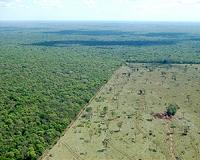| . |  |
. |
Boulder CO (SPX) Nov 04, 2010 The meters-long, carnivorous "shrimp" from hell that once ruled the seas of Earth a half billion years ago may have been a real softy, it turns out. A new 3-D modeling of the mouth parts of the Anomalocaris, along with evidence that these parts were not hard like teeth, but flexible, shows that the famed predator could not have been munching on the hard shells of trilobites and other such creatures of the early seas. What's more, there is no evidence from fossilized stomach contents or feces that Anomalocaris' ate anything hard enough to leave a fossilized trace. In fact it was this lack of fossil evidence backing any dietary preference - right alongside other animals that do show fragments of what they ate in their gullets - which inspired the investigation, said paleontologist James "Whitey" Hagadorn of the Denver Museum of Nature and Science. "It was supposed to roam around the Cambrian seas gobbling up trilobites and everything else," said Hagadorn. But the pineapple-like whorl of mouth parts and the associated whisker-like appendages of Anomalocaris all appear to have been bendable, in the fossil remains, he said. They are not mineralized like the exoskeletons of the trilobites they were supposedly eating. His suspicions prompted Hagadorn to develop a 3-D, finite element analysis model of the Anomalocaris mouth. This allowed for testing just how the mouth worked and how much force it could create - in other words, how strong a bite it had. The model turned up some surprises. "It couldn't even close its mouth," said Hagadorn. And there was no practical way these mouth parts could create the force needed to break open a modern lobster shell nor a shrimp shell, which were used as analogues for a trilobite carapace in the model. Another interesting discovery made along the way came from studying more than 400 Anomalocaris mouths. In none of them did Hagadorn find any signs of wear. That's strange because if they were genuine teeth there would be chips, scratches and other signs they were being used to munch on hard-shelled animals. The model, gut contents, feces and wear all suggest Anomalocaris was not a trilobite eater. But they fail to help explain what this impressive beast from the Cambrian was eating. "Maybe it ingested things and then spit them out," Hagadorn speculated. Another possibility is that it somehow broke down the food it was eating into very fine particles before ingesting it. At this point the only thing that appears certain is that the famed biggest predator of the early Cambrian is more mysterious than ever.
Share This Article With Planet Earth
Related Links Geological Society of America Darwin Today At TerraDaily.com
 Continuing Biodiversity Loss Predicted But Could Be Slowed
Continuing Biodiversity Loss Predicted But Could Be SlowedParis, France (SPX) Nov 04, 2010 A new analysis of several major global studies of future species shifts and losses foresees inevitable continuing decline of biodiversity during the 21st century but offers new hope that it could be slowed if emerging policy choices are pursued. Led by experts Henrique Miguel Pereira and Paul Leadley, the 23-member scientific team from nine countries, under the auspices of DIVERSITAS, UNEP ... read more |
|
| The content herein, unless otherwise known to be public domain, are Copyright 1995-2010 - SpaceDaily. AFP and UPI Wire Stories are copyright Agence France-Presse and United Press International. ESA Portal Reports are copyright European Space Agency. All NASA sourced material is public domain. Additional copyrights may apply in whole or part to other bona fide parties. Advertising does not imply endorsement,agreement or approval of any opinions, statements or information provided by SpaceDaily on any Web page published or hosted by SpaceDaily. Privacy Statement |